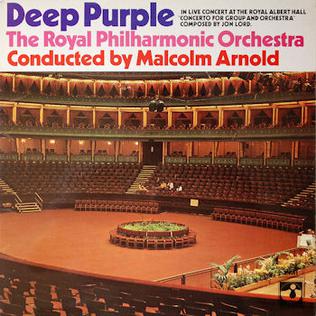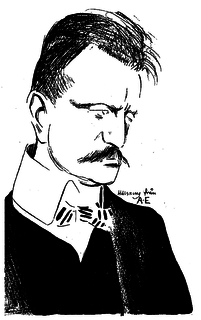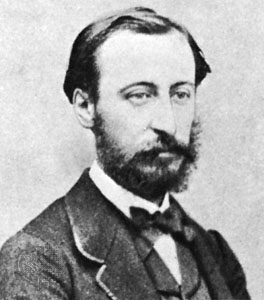
The Symphony No. 6 in A minor by Gustav Mahler is a symphony in four movements, composed in 1903 and 1904, with revisions from 1906. It is sometimes nicknamed the Tragic ("Tragische"), though the origin of the name is unclear.

Louis Moreau Gottschalk was an American composer and pianist, best known as a virtuoso performer of his own romantic piano works. He spent most of his working career outside of the United States.

Hugo Emil Alfvén was a Swedish composer, conductor, violinist, and painter.

Sergei Prokofiev wrote his Symphony No. 3 in C minor, Op. 44, in 1928.

Concerto for Group and Orchestra is a live album by Deep Purple and the Royal Philharmonic Orchestra conducted by Malcolm Arnold, recorded at the Royal Albert Hall, London, in September 1969. It consists of a concerto composed by Jon Lord, with lyrics written by Ian Gillan. It was released on vinyl in December 1969. The original performance included three additional Deep Purple songs, "Hush", "Wring That Neck", and "Child in Time"; these were included on a 2002 release.

Asger Hamerik (Hammerich), was a Danish composer of the late romantic period.

Ulvi Cemal Erkin was a member of the pioneer group of symphonic composers in Turkey, born in the period 1904–1910, who later came to be called The Turkish Five. These composers set out the direction of music in the newly established Turkish Republic. These composers distinguished themselves with their use of Turkish folk music and modal elements in an entirely Western symphonic style.

The Symphony No. 2 in D major, Op. 43, by Jean Sibelius was started in winter 1901 in Rapallo, Italy, shortly after the successful premiere of the popular Finlandia, and finished in 1902 in Finland. Sibelius said, "My second symphony is a confession of the soul."

The Piano Concerto No. 4 in C minor, Op. 44 was composed by Camille Saint-Saëns in 1875. It was premièred on October 31, 1875, at the Théâtre du Châtelet of Paris, with the composer as the soloist. The concerto is dedicated to Anton Door, a professor of piano at the Vienna Conservatory. It continues to be one of Saint-Saëns' most popular piano concertos, second only to the Piano Concerto No. 2 in G minor.
Tchaikovsky's Serenade for Strings in C major, Op. 48, was composed in 1880.
The American Suite in A major, Op. 98b, B. 190, is an orchestral suite written in 1894–1895 by Czech composer Antonín Dvořák.
Symphony No. 2 in E minor was written by Wilhelm Furtwängler between 1945 and 1946 in Switzerland. It is in four movements:
- Assai moderato - Allmählich belebend - Von hier ab festes Tempo (Allegro)
- Andante semplice (Tranquillo)
- Un poco moderato - Più Allegro - Più Moderato - Allegro - Moderato - Allegro
- Langsam - Moderato andante - Allegro molto - Moderato - Langsam - Moderato - Presto
Pyotr Ilyich Tchaikovsky composed his Orchestral Suite No. 3 in G, Op. 55 in 1884, writing it concurrently with his Concert Fantasia in G, Op. 56, for piano and orchestra. The originally intended opening movement of the suite, Contrastes, instead became the closing movement of the fantasia. Both works were also intended initially as more mainstream compositions than they became; the fantasia was intended as a piano concerto, while the suite was conceived as a symphony.
Orchestral Suite No. 1 in D minor is an orchestral suite, Op. 43, written by Pyotr Ilyich Tchaikovsky in 1878 and 1879. It was premiered on December 20, 1879 at a Russian Musical Society concert in Moscow, conducted by Nikolai Rubinstein. The piece is dedicated to Tchaikovsky's patroness, Nadezhda von Meck.
Rustic Wedding Symphony, Op. 26 is a symphony in E flat major by Karl Goldmark, written in 1875, a year before his renowned Violin Concerto No. 1. The symphony was premiered in Vienna on 5 March 1876, conducted by Hans Richter. Johannes Brahms, who was a frequent walking companion of Goldmark's, and whose own Symphony No. 1 was not premiered until November 1876, told him "That is the best thing you have done; clear-cut and faultless, it sprang into being a finished thing, like Minerva from the head of Jupiter". Its first American performance was at a New York Philharmonic Society concert, conducted by Theodore Thomas on 13 January 1877.
The Symphony No. 1 in C major by Mily Balakirev is scored for three flutes, oboe, English horn, three clarinets, two bassoons, four horns, two trumpets, three trombones, tuba, timpani, triangle, cymbals, snare drum, bass drum, two harps, first and second violins, violas, cellos and double basses.
The Frescoes of Piero della Francesca, H. 352, is an orchestral work by Bohuslav Martinů.
Roland Cardon was a Belgian composer, pedagogue, flautist, clarinetist and multi-instrumentalist. He often published works under the name Guy Rodenhof.
Benjamin Britten's Piano Concerto, Op. 13, is the composer's sole piano concerto.
Felix Mendelssohn wrote thirteen string symphonies between 1821 and 1823, when he was between 12 and 14 years old.. These symphonies were tributes to Classical symphonies especially by Joseph Haydn, Johann Christian Bach, Carl Philipp Emanuel Bach, and Wolfgang Amadeus Mozart.









